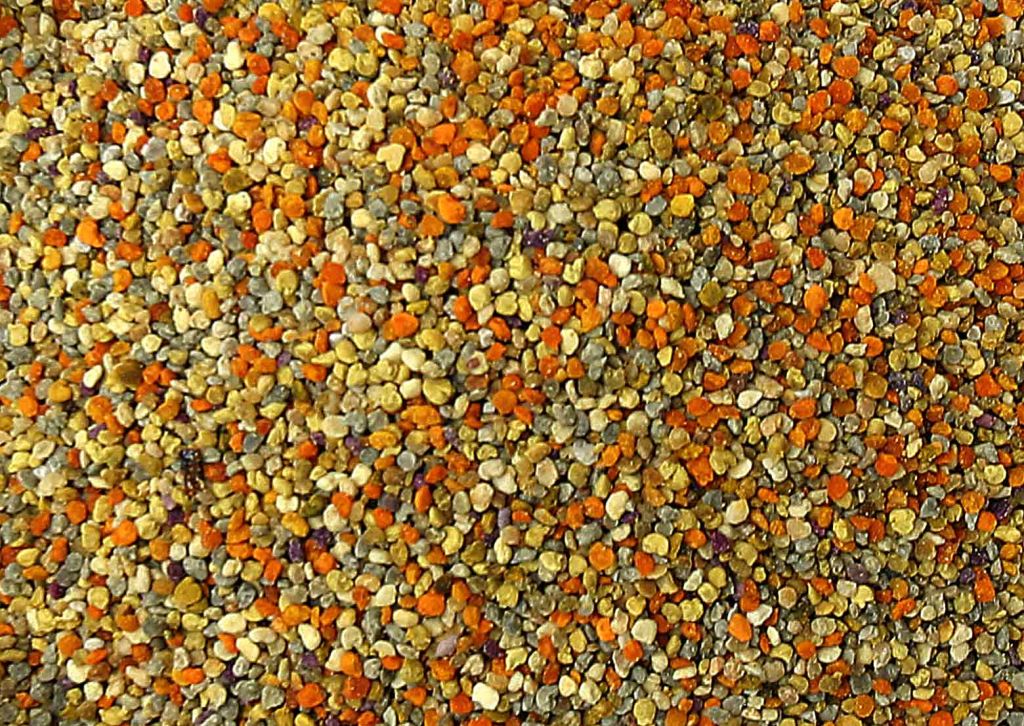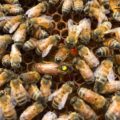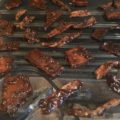Pollen, an often misunderstood resource in the hive. I’m just as guilty as the next person on possibly not fully appreciating the value of a healthy mixture of pollen in the hive. Last season, I was pulling out some of the pollen frames thinking that it was not going to be used, or that it was old and the bees were done with it. I was focused on making sure the bees perceived there was enough room for doing their work… both to manage swarming, and also to facilitate empty space for whatever the bees needed next.

I had some discussion with Garry Reeves recently on the topic of pollen, and we both agreed that last season, we both possibly removed pollen we assumed the bees were done with, but likely weren’t. First, how would we identify such old pollen? Can we? There’s many types of pollen we see in the hive. There’s new (dull/matte finish) pollen, glossy pollen, pollen with nectar or honey on top of it, and even entombed pollen, that is coated over and sealed off, behind a layer of propolis. We hope not to see entombed pollen in our hives, and more on that in a moment.
We already know the value of pollen in late winter, early spring. The queen needs it to fire up her egg-laying, but the bees need a healthy mixture of pollen from different sources on-going. It’s their primary protein and they mix it many ways to create the concoction they need next. Nurse, or “fat” bees need it to produce Vitellogenin (Vg) which is as much a miracle as royal jelly. There is good-quality and poor-quality pollen, so a variety of pollen is suggested to be a well-balanced diet.
This gets back to us pulling out frames of pollen. Is it possible the bees really would have used what we maybe thought was spent pollen? You can bet I’ll be leaving things alone this year to see. Our original intent was the thought of keeping the brood chamber open and available for needed resources. The decline I experienced last fall could have been varroa, but what about that one that made it through the mites? This spring, I had a marked queen with only a handful of bees. Not even enough to care for the eggs the queen started laying.
Bee hives have an ebb and flow too. When we do something, it’s safe to say we likely caused an affect on that hive that may not be seen for months, or maybe even the next season. Beekeepers should have a goal for each hive. Which will be used for honey, and which will be used for increasing? Those goals will dictate how you manage that hive and the changes we make do have an affect. Just like Tim Ives describes the ecology of the hive. Adding pollen substitute, feeding sugar, and even regular hive inspections have a big affect on the hive. Our actions must be timely and exact… as best we can 🙂
This year, I plan to let the bees keep their pollen and if that means sacrificing some space for more bees or honey, then so be it.
Entombed pollen, and interesting phenomenon
The entombed pollen phenomenon is described in a paper by Dennis vanEngelsdorp and published in the Journal of Invertebrate Pathology (2009). A quick abstract of that article is:
Entombed pollen is highly associated with increased colony mortality. Entombed pollen is sunken, capped cells amidst ‘normal’, uncapped cells of stored pollen, and some of the pollen contained within these cells is brick red in color. The increased incidence of entombed pollen in reused wax comb suggests that there is a transmittable factor common to the phenomenon and colony mortality. In addition, there were elevated pesticide levels, notably of the fungicide chlorothalonil, in entombed pollen. Additional studies are needed to determine if there is a causal relationship between entombed pollen, chemical residues, and colony mortality.
VanEngelsdorp and his group suggested that the worker bees sensed bad pollen in these cells and entombed it in propolis so it would not be consumed. Bees often cover offensive things with propolis i.e. hive beetles and other dead things to keep them from contaminating the hive, so this is consistent with other well-documented behavior.
Entombed pollen cells have been found to contain various types of chemicals, including those used to combat Varroa. It has been suggested that colonies containing entombed pollen are usually in the process of dying and entombing contaminated pollen may be a last effort made by a colony to save itself.
Current theories suggest that the accumulation of pesticides in a the smaller space of a hive could be more apparent to the bees than the same pesticide in a field, or perhaps the pesticides undergo chemical changes while stored in the hive, or mixed with other things. Nonetheless, this adds more chaos to the already challenging mystery of bee hive dead outs.





Leave a Reply